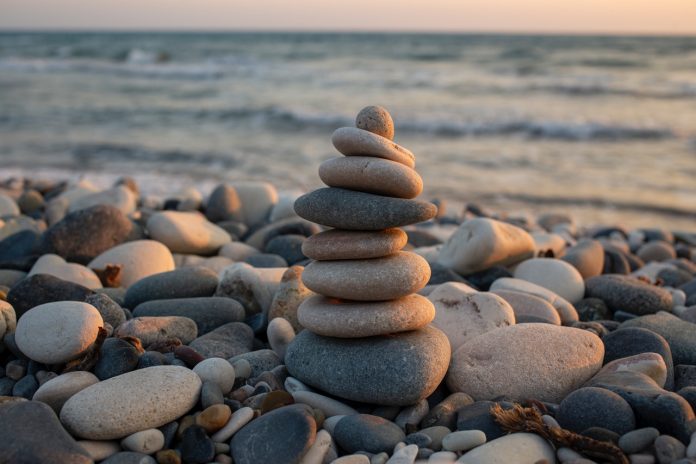
I recently found myself sitting on a bench at my neighbor’s house, staring into her koi pond, wondering how to make a Zen garden of my own.
I was surrounded by peaceful bliss. My neighbor had cultivated the perfect minimalist landscape to sit alone with one’s thoughts. The trees were all manicured and meticulously placed, while the babbling fountain drowned out all the neighborhood noise.
I’d seen plenty of miniature Zen gardens and dragged a rake through their sand to make playful patterns. But I’d never seen anything of this magnitude.
It was feeling so enraptured that led me to ask her how to make a Zen garden of my own.
What Is a Zen Garden?
 Before learning how to make a Zen garden, it’s essential to understand the purpose they serve. Zen gardens are not like English cottage gardens that are full of flowers and vibrancy. Instead, they tend to be more stark and artistic.
Before learning how to make a Zen garden, it’s essential to understand the purpose they serve. Zen gardens are not like English cottage gardens that are full of flowers and vibrancy. Instead, they tend to be more stark and artistic.
A Zen garden is for meditation and reflection, conceived and created by the gardener’s meditative inspiration. Though there are no set rules forbidding plants and water features, many Zen gardeners often omit them entirely, preferring a more minimalistic design.
A Zen garden comes from the Japanese term “karesansui,” which means “dry landscape” and refers to a garden made of only rocks and gravel. The Zen gardener places large rocks or boulders in a bed of gravel in strategic locations. These stones symbolize islands and mountains.
The gardener rakes the gravel in patterns to suggest flowing water. Though Zen gardens seem to have simple construction, in reality, you must rake crisp lines regularly to control unwanted weeds that may grow through the gravel. This raking becomes a daily meditation practice for the gardener.
History of Zen Gardens
 In learning how to make a Zen garden, I stumbled upon the interesting history of these gardens. Zen gardens are as old as Japanese culture.
In learning how to make a Zen garden, I stumbled upon the interesting history of these gardens. Zen gardens are as old as Japanese culture.
5th – 8th century: Taoism
There’s an ancient Taoist belief that somewhere in the middle of the ocean lay a group of three or five islands inhabited by immortals.
According to an old folktale, one day, a fisherman named Urashima Taro saves the life of a sea turtle. In return, the turtle takes him to visit the islands. Urashima stays, marries a princess, and also becomes immortal.
As time passes, the fisherman becomes increasingly homesick and makes the voyage back to his old village. In a sad twist of fate, once he sets foot on the familiar shore of his birthplace, he immediately grows old and dies
In a typical Japanese garden during this period, one would usually find a large pond surrounded by lush trees with an island or even just a big mountain-like rock in the middle. This island or rock was viewed as a symbol of Urashima’s land of perpetual youth and eternal life.
8th – 12th century: Buddhism
As Buddhist belief took over, Japan’s natural landscapes became more apparent in garden construction. Though the pond and island elements stayed, the rest of the elements were scrutinized and hand-picked with care.
Trees and flowers were chosen to change with the seasons to echo Buddha’s teachings of the never-ending cycle of death and rebirth.
14th – 16th century
Around the late 11th century, Zen gardens became the dry, rocky landscapes we know today. During this period, landscapers called “ishi-tate-so,” or “stone setting monks,” were responsible for designing and creating gardens.
These rock gardens completely rejected the meaningless facades of the material world; they were stripped bare and created mainly out of rocks and sand. Removing all the superfluous extras allowed Zen gardens to reveal the pure substance of life and nature.
Zen gardens became ponds without water. Instead of completely ignoring the ponds and water features, monks raked the gravel into wavy patterns to mimic the movement of water.
Philosophy of Zen Garden
 Traditional Zen gardens are not spaces for picnics or recreation. They are intended to be used for meditation and reflection.
Traditional Zen gardens are not spaces for picnics or recreation. They are intended to be used for meditation and reflection.
In Zen Buddhist tradition, reading scriptures and reciting prayers are not important. Instead, they are considered superficial activities. By undergoing long periods of sitting in meditation, as well as physical work, one can attain enlightenment.
By sitting in the rock garden, you find yourself in the right environment for contemplating nature and clearing your mind. Raking the sand or gravel isn’t meant to create something aesthetically pleasing. Instead, it gives you an activity to train your thought — a moving meditation.
What You Need to Make a Zen Garden
 Now that you have a better understanding of the history of Zen gardens, it’s time to learn how to make a Zen garden of your own.
Now that you have a better understanding of the history of Zen gardens, it’s time to learn how to make a Zen garden of your own.
Let’s start with the supplies. Because of the minimalist nature of Zen gardens, you really don’t need a lot to get started.
Rocks or boulders
These are the key elements of any Zen garden, as they represent land and mountains, alluding to the islands of the immortals.
Be sure not to crowd your space. If you have a small space, choose large rocks instead of boulders to maintain simplicity.
Gravel or water feature
Gravel or sand is used in traditional Zen gardens to represent water. Sand is lighter and may blow away if not in a protected area of your yard. Crushed stone or small pebbles work well.
You can also use an actual water feature if you’d like. A small fountain or pond can help put you in a meditative spirit.
Bench, statue, or other focal points (optional)
Since you’ll be spending a lot of time sitting in your garden, we suggest installing a comfortable bench to sit on while you contemplate life’s great mysteries.
You may also choose to methodically place a statue or some other focal point in the garden for training your focus during meditation.
Plants and flowers (optional)
 To create a traditional Zen garden, forgo the plants. If you’re less rigid about the rules and trying to create the right space for you, choose plants that suit your location. If you have pets, be sure to stick to non-toxic plants.
To create a traditional Zen garden, forgo the plants. If you’re less rigid about the rules and trying to create the right space for you, choose plants that suit your location. If you have pets, be sure to stick to non-toxic plants.
For a sunny corner of your yard, choose plants that love the sun. On the other hand, for a shady corner, go for plants that prefer the shade.

